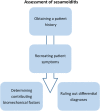The assessment and management of sesamoiditis: a focus group study of podiatrists in Aotearoa New Zealand
- PMID: 37194098
- PMCID: PMC10186644
- DOI: 10.1186/s13047-023-00628-w
The assessment and management of sesamoiditis: a focus group study of podiatrists in Aotearoa New Zealand
Abstract
Background: Sesamoiditis is a common inflammatory condition affecting the sesamoid bones at the plantar aspect of the first metatarsophalangeal joint (1MTPJ). However, there are currently no recommendations or clinical guidelines to support podiatrists in their assessment or management of sesamoiditis. The aim of this study was to explore the views of podiatrists in Aotearoa New Zealand on their approaches to the assessment and management of patients with sesamoiditis.
Methods: This qualitative study included focus group discussions with registered podiatrists. Focus groups took place online via Zoom and were guided by a detailed focus group question schedule. The questions were designed to encourage discussion around assessment approaches used in the diagnosis of sesamoiditis and the treatment tools used to manage patients with sesamoiditis. Focus groups were audio-recorded and transcribed verbatim. Reflexive thematic analysis was used to analyse the data.
Results: A total of 12 registered podiatrists participated in one of three focus groups. Four themes were constructed relating to the assessment of sesamoiditis: (1) obtaining a patient history; (2) recreating patient symptoms; (3) determining contributing biomechanical factors; and (4) ruling out differential diagnoses. Seven themes were constructed relating to the management of sesamoiditis: (1) consideration of patient factors; (2) patient education; (3) cushioning of the sesamoids to allow more comfortable weightbearing of the 1MTPJ; (4) pressure redistribution and offloading of the sesamoids; (5) immobilisation of the 1MTPJ and sesamoids; (6) facilitating efficient sagittal plane motion during gait; (7) referring to other health professionals to find different ways to treat or manage patient symptoms.
Conclusion: Podiatrists in Aotearoa New Zealand demonstrate an analytical approach in the assessment and management of patients with sesamoiditis based on their clinical experience and knowledge of lower limb anatomy. A range of assessment and management techniques are selected based on the practitioners personal preferences, as well as the patient's social factors, symptomology, and lower limb biomechanics.
Keywords: First metatarsophalangeal joint; Focus groups; Podiatry; Qualitative; Sesamoiditis.
© 2023. The Author(s).
Conflict of interest statement
SS and MC are on the editorial board for the Journal of Foot and Ankle Research. PK declares no competing interests.
Figures
Similar articles
-
The development of recommendations for the assessment and management of sesamoiditis by podiatrists: A Delphi and content validity study.J Foot Ankle Res. 2024 Jun;17(2):e12025. doi: 10.1002/jfa2.12025. J Foot Ankle Res. 2024. PMID: 38820171 Free PMC article.
-
Navigating diagnostic uncertainty in children's chronic lower limb pain: A qualitative study of management strategies using vignette-based focus groups.J Foot Ankle Res. 2025 Mar;18(1):e70032. doi: 10.1002/jfa2.70032. J Foot Ankle Res. 2025. PMID: 40042426 Free PMC article.
-
Health professional views on the assessment and management of foot problems in people with psoriatic arthritis in Australia and New Zealand: a qualitative investigation.BMC Musculoskelet Disord. 2019 May 4;20(1):191. doi: 10.1186/s12891-019-2572-6. BMC Musculoskelet Disord. 2019. PMID: 31054575 Free PMC article.
-
Turf toe and sesamoiditis: what the radiologist needs to know.Clin Imaging. 2015 May-Jun;39(3):380-9. doi: 10.1016/j.clinimag.2014.11.011. Epub 2014 Nov 20. Clin Imaging. 2015. PMID: 25482355 Review.
-
An evaluation of podiatry service use for people with inflammatory rheumatic diseases: a review of a rheumatology podiatry clinic in Aotearoa New Zealand.J Foot Ankle Res. 2022 May 16;15(1):36. doi: 10.1186/s13047-022-00542-7. J Foot Ankle Res. 2022. PMID: 35578311 Free PMC article. Review.
Cited by
-
A Less Common Anatomical Variant of Bilateral Multiple Lesser Metatarsal Sesamoids With Radiologic and Clinical Correlation.Cureus. 2025 May 25;17(5):e84771. doi: 10.7759/cureus.84771. eCollection 2025 May. Cureus. 2025. PMID: 40433024 Free PMC article.
-
The development of recommendations for the assessment and management of sesamoiditis by podiatrists: A Delphi and content validity study.J Foot Ankle Res. 2024 Jun;17(2):e12025. doi: 10.1002/jfa2.12025. J Foot Ankle Res. 2024. PMID: 38820171 Free PMC article.
-
Conservative Treatment of Sesamoiditis: A Systematic Literature Review with Individual-Level Pooled Data Analysis.Medicina (Kaunas). 2025 Jul 3;61(7):1215. doi: 10.3390/medicina61071215. Medicina (Kaunas). 2025. PMID: 40731844 Free PMC article. Review.
References
-
- Schweitzer ME, Karasick D. Disorders of the hallux sesamoid complex - MR features. Int Skeletal Soc. 1988;27:411–418. - PubMed
MeSH terms
LinkOut - more resources
Full Text Sources



